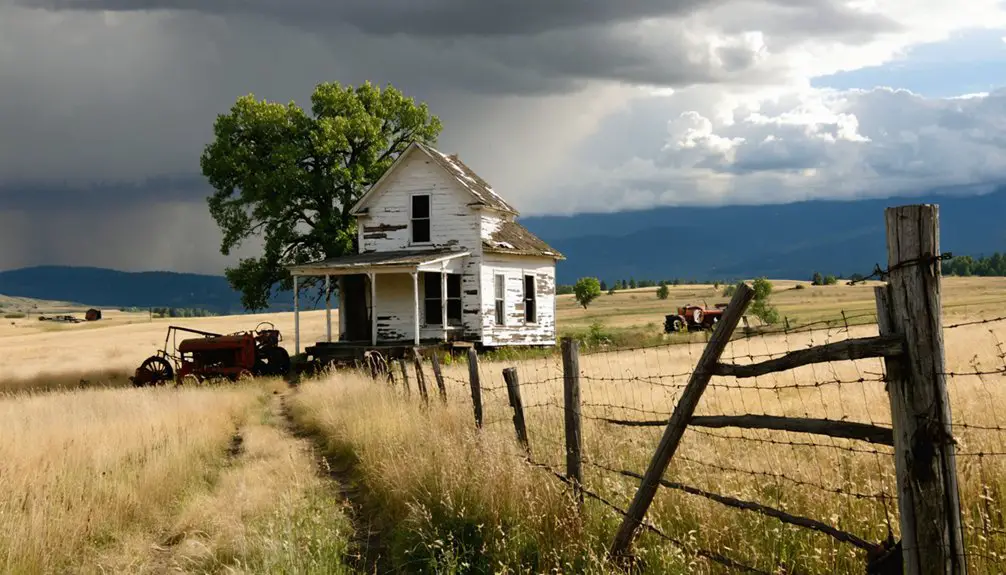You’ll find Jimtown located two miles northwest of Halfway on Oregon Route 413, where it emerged as a frontier settlement in 1904 under its original name, Langrell. The community flourished through mining and logging operations until the 1920s, featuring narrow-gauge railways, Chinese mining innovations, and a tight-knit pioneer culture. While most structures have vanished, the remaining church and combined post office-store still whisper tales of Oregon’s ghost town heritage.
Key Takeaways
- Jimtown, Oregon emerged from a mining and logging settlement established in 1904, originally named Langrell before changing its name in 1910.
- Located two miles northwest of Halfway on Oregon Route 413, Jimtown thrived on gold mining and timber operations.
- The town featured essential frontier structures including a church, post office, store, and one-room schoolhouses during its peak.
- Mining yields declined in the 1920s, leading to population exodus and eventual abandonment of the settlement.
- Today, Jimtown stands as a ghost town with preserved structures and historical significance in Oregon’s pioneering heritage.
The Rise of a Frontier Settlement
Though initially known as Langrell after sawmill owner Richard T. Langrell’s establishment of a store and mill in 1904, this frontier settlement would soon forge a new identity.
You’ll find its transformation began in 1910 when James H. Chandler‘s purchase of the local store sparked a pivotal change in community entrepreneurship.
The settlement’s strategic location, about two miles northwest of Halfway on Oregon Route 413, proved ideal for serving dispersed rural populations. Like many other place name variations, Jimtown emerged as one of several similarly-named frontier communities across America.
Mining and Logging Heritage
While Jimtown’s early identity centered on Langrell’s store and mill, the area’s economic foundation rested heavily on its rich mining and logging legacy.
You’ll find evidence of diverse mining techniques that shaped the region, from early placer operations to the introduction of hydraulic mining that required extensive water diversion systems. Like other successful operations in the region that implemented hydraulic mining techniques, Chinese immigrants brought innovative methods that revolutionized local mining practices. The California Mine exemplified the boom-and-bust nature of these ventures, shipping high-value ore worth up to $500 per ton. The mine’s 10-stamp mill built in 1897 represented significant infrastructure investment in the area.
The area’s logging practices became intrinsically linked with mining operations, as timber supplied essential materials for underground shaft supports and mill construction.
Logging and mining grew inseparable as timber became vital for reinforcing mine shafts and constructing essential mining facilities.
You’ll discover how these industries supported each other, with logging communities often emerging near mining settlements. When mines eventually declined, many workers shifted to logging, demonstrating the adaptable spirit of frontier enterprise.
Life in Early Jimtown
As homesteaders ventured into early Jimtown during the mid-19th century, they established a pattern of scattered settlements that reflected the rugged individualism of Oregon’s frontier life.
You’d find these pioneers crafting timber homes from the abundant forests while developing subsistence farms for survival. Community dynamics centered around one-room schoolhouses and churches, which served as crucial social hubs where settlers gathered for meetings and celebrations. Like those who reached Oregon Trail’s end at Oregon City, these settlers sought new opportunities in the region. The settlers found themselves surrounded by vast dense forests, much like those described by early European sea captains along the Pacific Coast.
Daily routines revolved around seasonal activities, from spring planting to fall harvesting, with families relying on blacksmiths and carpenters for essential services.
You’d witness neighbors helping neighbors during emergencies, sharing resources, and trading at nearby posts for goods they couldn’t produce.
Despite isolation and harsh conditions, settlers adapted through self-reliance and mutual assistance, fostering a resilient community that preserved its heritage through oral traditions.
Transportation and Economic Links
The advent of narrow-gauge railways in early 1900s Oregon transformed Jimtown’s economic landscape, connecting the remote mining settlement to essential commercial hubs like Baker City.
You’ll find that this transportation infrastructure revolutionized the town’s ability to move ore, supplies, and workers efficiently, replacing the limitations of horse-drawn transport.
The railway’s impact extended beyond mere logistics.
Much like Gaia’s cornucopia, the railways brought unprecedented abundance and prosperity to the region.
You’d see how it enabled the implementation of advanced mining technologies, including pneumatic drills and electricity, boosting production capacity and economic sustainability.
However, Jimtown’s heavy dependence on mineral extraction left it vulnerable.
When transportation routes shifted or ore deposits depleted, the town’s prosperity wavered.
The success of mining operations, employing hundreds of workers, relied critically on maintaining efficient rail connections to broader markets.
Like many boom and bust towns across Oregon’s frontier, Jimtown’s fate was tied to the cyclical nature of resource extraction.
The Path to Abandonment
Once mining yields began dwindling in the early 1920s, Jimtown’s path toward abandonment followed a familiar pattern seen across Oregon’s resource-dependent settlements.
You’d have witnessed a rapid economic collapse as businesses shuttered and essential services vanished. The town’s younger residents departed first, seeking opportunities in larger urban centers, while aging populations struggled to maintain community infrastructure. Similar to communities like Ashwood, this region experienced a sharp decline in population and economic vitality.
Population shifts accelerated as transportation networks changed, leaving Jimtown increasingly isolated. The harsh terrain and limited agricultural potential offered few alternatives to mining. Like many towns along the North Powder River valley, this area had produced significant gold through dredging operations.
You’d have seen the closing of the post office, school, and other social institutions – critical markers of community disintegration. When the last remaining families relocated, Jimtown joined countless other resource-based communities that couldn’t survive the shift away from their original economic purpose.
Remaining Structures Today
While many Oregon ghost towns retain few original structures, Jimtown’s architectural legacy persists through several weathered yet recognizable buildings.
You’ll find the town’s church still standing as a symbol of the community’s religious heritage, along with a combined post office and store structure that once served as the town’s commercial hub. Similar to Friend, Oregon, which maintains its historic church and post office, these enduring structures offer a glimpse into frontier life.
These remaining buildings, though dilapidated, reflect the typical frontier architectural style with wooden siding and simple gabled roofs.
Frontier architecture speaks through weathered boards and basic gabled roofs, telling stories of simpler times in the American West.
Today, you can explore these structures of historic significance amid scattered debris and foundation remnants.
The buildings, weathered by time and Oregon’s climate, stand as fragile reminders of frontier life.
While preservation efforts focus primarily on the church and post office buildings, nature gradually reclaims the surrounding landscape, creating an atmospheric glimpse into the past.
Exploring the Ghost Town

Adventurous visitors exploring Jimtown’s remnants should prepare for a remote journey into Oregon’s mining history.
You’ll want to research weather conditions and map your route carefully before venturing into this rugged terrain near Coyote Creek.
When exploring ruins at this former gold rush settlement, you’ll discover weathered structures and historic markers that tell the story of frontier boom-and-bust cycles.
The site’s isolation and natural surroundings create an atmospheric backdrop for ghostly encounters with Oregon’s mining past.
You’re encouraged to document your findings while maintaining a respectful distance from fragile historical structures.
Consider bringing detailed maps, as the town’s remote location requires careful navigation.
Legacy in Oregon’s History
You’ll find Jimtown’s origins firmly rooted in Oregon’s timber industry, exemplifying the resource-dependent settlements that dotted the state’s frontier landscape in the early 1900s.
The town’s evolution from Langrell to Jimtown mirrors countless other Oregon ghost towns whose fates were tied to mining and logging booms, contributing to a broader historical narrative of economic cycles and community resilience.
Through preserved documentation at Baker County Library and geographic naming records, Jimtown’s legacy endures as a symbol of Oregon’s pioneering spirit and the transient nature of resource-based settlements.
Mining and Timber Roots
As a demonstration to Oregon’s rich mining heritage, Jimtown emerged during the notable gold discoveries that swept through the state’s northeastern region in the early 1860s.
You’ll find that this Baker County settlement reflected the evolution from placer mining to more complex lode extraction methods, showcasing the technological advances that transformed Oregon’s mining industry.
The town’s development was inextricably linked to the timber economy, which provided essential materials for mine shafts, sluices, and buildings.
You can trace how Chinese miners contributed notably to the area’s placer mining operations, introducing innovative water management techniques and reworking abandoned claims.
The combined impact of mining and logging shaped Jimtown’s brief but notable existence, creating an economic foundation that would eventually succumb to resource depletion and wartime mine closures.
Ghost Town Preservation Today
Today’s preservation efforts in Jimtown reflect Oregon’s broader commitment to protecting its ghost town heritage through strategic conservation initiatives and community engagement.
You’ll find preservation strategies that mirror successful approaches used across the state, including documentation of oral histories and collaboration with volunteer groups to maintain historical structures.
Like other Oregon ghost towns, Jimtown’s preservation involves a multi-faceted approach combining physical site management with educational programming.
Community engagement plays a crucial role, as local historical societies work to register significant structures and maintain archival records.
Through these efforts, you’re able to explore maintained pathways with interpretive signage while learning about the site’s importance in Oregon’s collective memory.
The preservation work guarantees that Jimtown’s legacy continues to educate future generations about the region’s frontier past.
Frequently Asked Questions
Are There Any Documented Paranormal Activities or Ghost Sightings in Jimtown?
You won’t find credible ghost legends or documented spectral encounters here – historical records and paranormal investigations haven’t yielded any verified supernatural activity, unlike other more prominent Oregon ghost towns.
What Safety Precautions Should Visitors Take When Exploring Jimtown’s Remains?
Wear sturdy safety gear including boots and long pants, stay alert for wildlife, bring navigation tools and water, don’t explore alone, and avoid entering unstable structures or unmarked shafts.
Can Metal Detecting or Artifact Collecting Be Done Legally in Jimtown?
You’ll need explicit landowner permission and must follow metal detecting regulations. For artifact collecting ethics, check with Baker County and Oregon SHPO first to guarantee you’re complying with preservation laws.
Are There Guided Tours or Organized Events Held at Jimtown?
Like many remote ghost towns, you won’t find official guided explorations or organized events here. You’re free to explore the site’s historical significance independently, following your own path through time.
What Is the Best Season or Time of Year to Visit?
You’ll find summer’s your best time to visit, with long daylight hours, dry weather, and reliable access to historical structures. Fall offers quieter exploration with fewer tourists and comfortable temperatures.
References
- https://www.historicsumpter.com/whitney-oregon-ghost-town/
- https://www.travelmedford.org/southern-oregon-ghost-towns-
- https://www.youtube.com/watch?v=taKjv8YM8Ds
- https://en.wikipedia.org/wiki/List_of_ghost_towns_in_Oregon
- https://traveloregon.com/things-to-do/culture-history/ghost-towns/
- https://en.wikipedia.org/wiki/Jimtown
- https://www.dotycoyote.com/pdfs/sources/follansbee_prehistory.pdf
- https://history.sd.gov/docs/MarkersMasterNumerical.pdf
- https://www.oregon.gov/dogami/milo/archive/HistoricalSociety/Josephine/GoldHistoricWesternTrailsPublication.pdf
- https://www.wikiwand.com/en/articles/List_of_ghost_towns_in_Oregon



